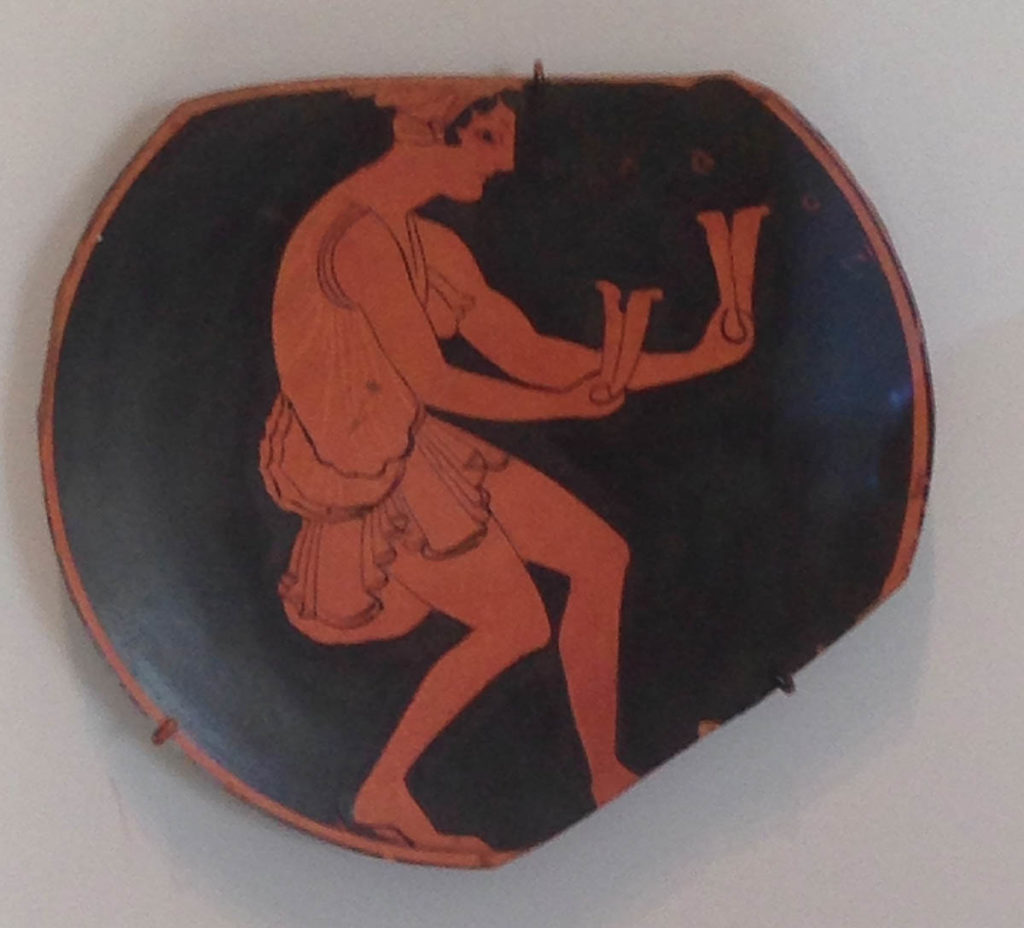“Instrument Interview” posts are a chance to sit down with the instruments of traditional, country, bluegrass, and roots music – from different types of instruments to specific ones related to artists, luthiers, and songwriters – and learn more about them. Ten questions are posed, and the instruments answer! Today we talk with the bones.
What are you?
I am a type of percussive instrument known as a “concussion idiophone,” which refers to me being made of up of similar objects that make a sound when struck together. I’m also called the “rhythm bones,” which gives you a clue to the role I play in music.

Where do you come from?
I’ve been around for a long time, and you can find versions of bones all the way back to several ancient cultures. Archaeologists have excavated bones (as instruments) from graves and tombs in prehistoric Mesopotamia and Egypt, and also discovered images of musicians playing the bones on Greek pottery. There is also evidence of the bones being played in the Roman Empire and ancient China. More recently – that is, in the 18th and 19th centuries – I came to North America with Irish and English immigrants, who used the bones as a way to keep a steady beat for their jigs and reels.

Fragment of a terra cotta red-figure kylix, Greek, 510-500 BC. The image is of a dancer using a bones-like instrument as part of the performance. Public domain
Are you really made from bones?
My original versions were made from animal bones, usually the rib or shin bones of sheep, cows, and sometimes horses. I’m often slightly curved, reflective of the natural shape of these bones, and I typically measure between 5 and 7 inches in length. While modern bones are still made from animal bones, you can also find ones made from wood and plastic. A variety of woods can be used, such as cherry, mahogany, walnut, and maple, with different woods producing different tones as is seen in other wooden instruments.
How are you played?
Players hold a pair of bones between their fingers with the convex sides facing one another; one is held fairly tightly and the other more loosely. By shaking the wrist, the bones hit one another, creating a loud “clack.” The connection between the two bones is carried by the momentum from the player’s arm and hand movements rather than any effort to force the bones to knock together. In North America, players tend to play with a pair of bones in each hand, while in Ireland the tradition is to play one-handed.
It’s hard to get a sense of what the movement looks like and the resulting sound by describing it, so check out Dom Flemons playing the bones. It’s actually quite amazing – and beautiful – to watch:
What type of music are you typically found in?
You can hear bones being played in a wide variety of genres, such as traditional Irish and Scottish music, blues, bluegrass, zydeco, French-Canadian music, and Cape Breton (in Nova Scotia) traditions.
Because bones were also often used by African American musicians, they became a common facet of 19th-century minstrel shows – where white performers appeared in blackface; later Black entertainers appeared in minstrel shows too – and the bones’ popularity in the United States grew within this context. One of the first bones-playing minstrel performers was Frank Brower, and the first documentation of him playing the bones in front of an audience are from 1841 in Virginia. He played with a much larger pair of bones than is usual today – two 12-inch lengths of horse rib bones!

Are there famous musicians associated with the bones?
There are many famous bones players! Freeman Davis, known by his stage name “Brother Bones” and also as “Whistling Sam,” was born in Montgomery, Alabama, in 1902. He recorded several songs in the 1940s and 1950s, appeared in three movies, and performed at Carnegie Hall and on The Ed Sullivan Show. His most famous recording is “Sweet Georgia Brown,” which became the Harlem Globetrotters’ theme tune in 1952. He took bones playing to an intense high of four bones in each hand and even playing knives like bones!
DeFord Bailey, best known for his wonderful harmonica playing and as a regular on the Grand Ole Opry in its early days, included bones playing in his performances along with yo-yo tricks and guitar picking. He was country music’s first African American star.
John Burrill learned to play the bones in his teens during the Depression. One viewer described Burrill’s style of bones-playing as looking like his arms were upside-down windshield wipers. Over the years, Burrill played with a host of other musicians and acts, including the Brattle Street Players, Steve Baird, Clifton Chenier, Spider John Koerner, Molly Malone, and even the Infliktors, a punk band. When asked what key he played in, his reply was “the skeleton key”!
Peadar Mercier was a percussionist in the Irish band The Chieftains, playing both the bodhran and the bones. He was with them from 1966 to 1976.
Dom Flemons, one of the founding members of the Carolina Chocolate Drops and now a solo artist, is known as the American Songster, whose “repertoire of music covers over 100 years of early American popular music.” Flemons is a talented multi-instrumentalist, playing banjo, guitar, harmonica, jug, quills, fife, and, of course, the bones. He has bones made out of cow rib and shin bones that he plays in the double-handed style.
I’ve heard of someone called “the Rhythm Bones King.” Who was he?
The Rhythm Bones King is a man called Joe Birl. In 1945 Birl applied for a patent for his black molded plastic bones that bore a groove to help keep the bones from slipping out of a player’s hand. Birl produced and sold around 150,000 pairs of these plastic rhythm bones. After the plastic mold broke, he made wooden rhythm bones with his patented grooved design. He passed away in 2012, and Joe Birl Jr. continued to sell bones made in his father’s design.

Were you played at the Bristol Sessions?
I was! Black musician El Watson played me when he accompanied the Johnson Brothers on two recordings – “Two Brothers Are We” and “I Want to See My Mother (Ten Thousand Miles Away).” He also accompanied them on harmonica for their recording of “The Soldier’s Poor Little Boy,” and Charles Johnson played guitar on Watson’s two harmonica recordings, “Pot Licker Blues” and “Narrow Gauge Blues.” These are some of the earliest integrated country music and blues recordings.
Are there other instruments related to you?
There are many other types of percussive instruments that are used in a similar way to the bones. For instance, clappers – consisting of two solid pieces made of wood, metal, ivory, and even plastic that are slapped together – are found in a lot of musical traditions, from China, Japan, Korea, and Thailand to medieval France and modern Western symphony orchestras.
Castanets are made of two concave shells joined with string at one edge. They are usually made of chestnut wood, and they are played two-handed. Castanets are also used in several musical traditions, such as Spanish, Portuguese, Swiss, Moorish, Ottoman, Sephardic, and Italian.
Playing the spoons is especially common in American folk music and often seen in jug bands. Like the bones, the spoons are held in one hand and played against each other as a percussive instrument. To see some amazing spoon playing, check out Abby the Spoon Lady.
Anything else you want to share with us?
Remember singing the nursery rhyme song “This Old Man” when you were a child? Well, that song is thought to refer to bones playing! The first verse goes like this (and so on):
“This old man, he played one,
He played knick-knack on my thumb;
With a knick-knack paddywhack,
Give a dog a bone,
This old man came rolling home.”
A paddywhack is a ligament – known as the nuchal ligament – in the neck of sheep and cattle.
*Want some of your own bones? Then stop by The Museum Store where you can buy wooden bones (and spoons) made by local artisan Walt Messick of Mouth of Wilson, Virginia.


